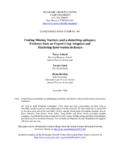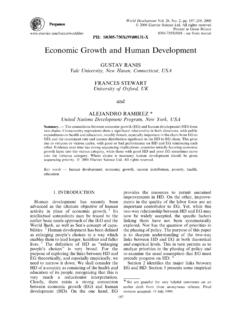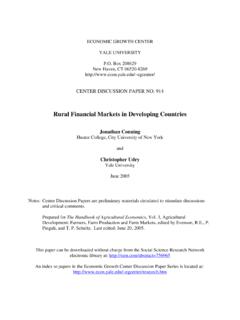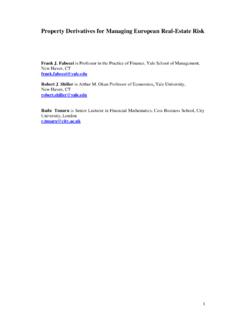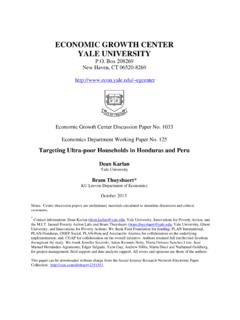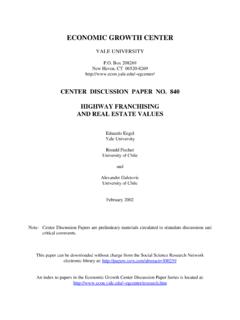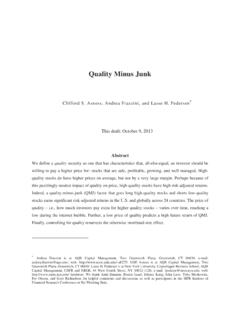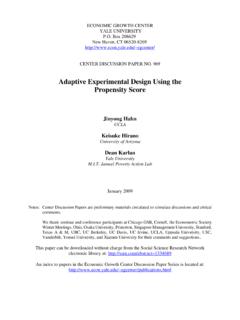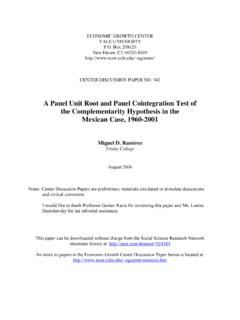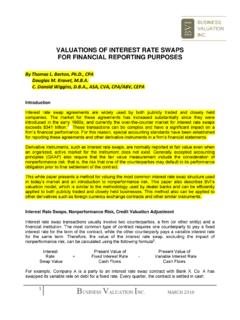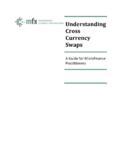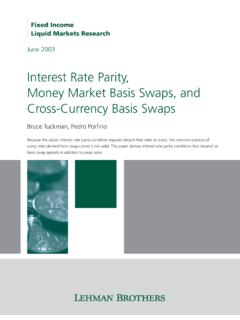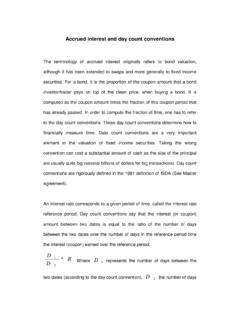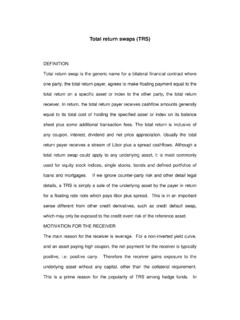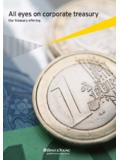Transcription of Costas Arkolakis teaching fellow: Federico Esposito
1 Exchange RatesCostas Arkolakisteaching fellow : Federico EspositoEconomics 407, YaleJanuary 2014 Outline De nitions: Nominal and Real Exchange Rate A Theory of Determination of the Real Exchange Rate Foreign Exchange Market Price Arbitrage: Purchasing Power Parity Interest Rate Arbitrage: Uncovered and Covered Interest Rate Parity Determination of the Nominal Exchange RateDe nitions: Nominal Exchange Rate (NER) Nominal Exchange Rateis the price of a foreign currency in terms ofthe home currency E$/e= exchange rate (in US terms, Dollars per Euro) Ee/$= exchange rate (in European terms, Euros per Dollar) Thus,E$/e=1/Ee/$ An increase inE$/emeans a dollar depreciation. If a currency can buy more (less) of another currency, we say it has beenappreciated (depreciated) "E$/eorEe/$#: dollar depreciation, euro appreciationNominal vs Real Exchange rates (RER) Real exchange rateis the Nominal Exchange rate times the inverse ofthe relative price levels Dollar pound real exchange ratee$/ =E$/ PUKPUS whereE$/ :dollar price of 1 pound,PUK: is the price level in UK,PUSprice level in US e$/ : the relative price of a consumption basket in the UK in terms ofconsumption in USUS dollar depreciation vs other Currencies Makes US residents relatively poorer Makes US products cheaper to foreignersFigure:Source.
2 Feenstra and Taylor 2010US dollar depreciation vs other Currencies Makes US residents relatively poorer Makes US products cheaper to foreignersUS dollar Depreciation and AppreciationCurrency Crisis: Argentinian Peso depreciation Between Jan and Jul 02, Argentine Peso depreciated 70% What does it mean for Argentinians?Headline News: E ects on Argentinians Consequences of the Argentinian devaluation episode Jan 2002, Argentine gov. announced default on $155 billion in debt. Unrest, political upheaval As of 2006, unemployment rate was still 10%. In ation increased dramatically for 2 years, still remains high. Real GDP in dollars fell :Argentine and World Real GDP per capita in $ (World Bank)Figure:Real Exchange Rate DeterminationReal Exchange rates Real exchange rates are persistentFigure:Consumer Price Indices (CPI) for UK and US in US dollar terms (log scale).
3 Taylor and Taylor, Journal of Economic Perspectives, Theory of Determination of the Real Exchange Rate Objective: A Theory of What Determines RER A Theory of RER is far easier to develop: In general, economic theories work better with real than nominalmagnitudes Step 1: Derive a relationship between RER and relative prices Step 2: Derive a relationship between relative prices and economicfundamentalsStep 1: RER and Relative Prices De nitions:. PT:price of tradeables, PN:price of non-tradeables, P:overall price level * indicates foreign variable. Assumptions: Law of one price holds for traded goodsPT=EP T For nontraded goods, in general,PN6=EP NStep 1: RER and Relative Prices Assume the price level,P, is a function (.,.)of the price of tradablesand nontradables,P= (PT,PN), where is homogeneous of degree 1 Homogeneous of degree 1: (x,y)= (x/ ,y/ ), or (x,y)= ( x, y)The Impact of Non-Tradables in the RER AssumeP= (PT,PN)where is homogeneous of degree 1e EP P=E (P T,P N) (PT,PN)=EP T 1,P NP T PT 1,PNPT Now use Law of one price for tradeables,PT=EP T,e= 1,P NP T 1,PNPT The Impact of Non-Tradeables in the RER Law of one price impliese= 1,P NP T.
4 1,PNPT Therefore,e>1 ifP NP T>PNPT., RER depends on relative prices oftradeables to non-tradeables Is this true in the data? We will study the academic research on this hypothesis in detail later on The last piece of the theory is to develop a theory of howPNPT isdetermined The Balassa-Samuelson e ectThe Impact of Non-Tradeables in the RER Law of one price impliese= 1,P NP T . 1,PNPT Therefore,e>1 ifP NP T>PNPT., RER depends on relative prices oftradeables to non-tradeables Is this true in the data? We will study the academic research on this hypothesis in detail later on The last piece of the theory is to develop a theory of howPNPT isdetermined The Balassa-Samuelson e ectStep 2: Relative Prices & Economic Fundamentals(Balassa-Samuelson) A theory with Nontradeables and Tradeables 2 goods, traded:QT, non-traded:QN Production functions:QT=aTLT,QN=aNLN ai:productivity,Li:labor used,wherei=T,N Pro ts in each sectorPiQi wLi, wherei=N,T Zero pro t condition:PiQi=wLi, fori=N,T Using production functionsPiaiLi=wLi=)w=Piai Therefore,PNPT=aTaNThe Balassa-Samuelson E ect in the DataFigure.
5 Di erent Productivity Growth and changes in Relative Price ofNon-tradeablesForeign Exchange MarketThe Market for Foreign Exchange Exchange rates are set minute by minute in the Foreign Exchange(Forex) market Individuals, corporations, public institutions trade currencies An over-the-counter market since it is not an organized exchange market The global currency trade is trillion per day, 290% more than in 1992 Major exchange centers: UK, US, JapanLargest Currency TradersSpot Contracts Spot exchange: a contract for immediate exchange of currencies In the rest of the course, we will mostly talk about spot contracts How it works Trader 1 calls Trader 2 and asks for a price of a currency, say GBP The bid price is the exchange rate (ER) at which 2 is willing to buy GBP The ask (or o er) price is the ER at which 2 is willing to sell GBP The di erence (bid-ask spread) generates pro ts for Trader 2 Derivatives Derivatives: contracts for which their pricing is derived from the spotrate Forwards, swaps , futures and options.
6 These contrants exist to allow investors to trade currency for delivery atdi erent times or with di erent contigencies Forwards: It is a contract where the settlement date for the delivery ofthe currencies is forward in the future for a set price the time of the delivery -the maturity- could be 90 days from now, ayear from now etc Because the contract has a xed price it carries no Arbitrage: Purchasing Power ParityAbsolute & Relative Purchasing Power Parity (PPP) Absolute PPP: Real exchange rate is expected to be 1 Absolute Purchasing Power Parity would imply:log(E$/ PUK) log(PUS) PPP refers to the price index while law of one price to one good at a time Relative PPP implies that there no expected movements in theReal exchange rate Relative Purchasing Power Parity would imply:dlog(E$/ PUK) dlog(PUS)Absolute Purchasing Power Parity Absolute PPP: Real exchange rate is expected to be 1 Absolute Purchasing Power Parity would imply:log(E$/ PUK) log(PUS) PPP is based on the law of one price: in the absense of transactioncosts, prices should be the same across markets because of arbitrage In the short run, obviously this is not PPP in the Data If all the goods were instantly tradeable, PPP theory should betrue!
7 Not true in the short true in the :Consumer Price Indices (CPI) for UK and US in US dollar terms (log scale).Taylor and Taylor, Journal of Economic Perspectives, for Relative PPP Postulate thatlog Et$/ PtUK log(PtUS)for some timet. We know that for small periods, it may not hold. Can it hold over largeperiods of time? Consider the following derivationlog Et$/ PtUK log Et n$/ Pt nUK log PtUS log Pt nUS =)log Et$/ /Et n$/ +log PtUK/Pt nUK log PtUS/Pt nUS =)log(Et$/ /Et n$/ )|{z}change inexchange rate log(PtUS/Pt nUS|{z})Ratio of pricesin the US (in ation) log(PtUK/Pt nUK)|{z}Ratio of pricesin the UK (in ation) We can now proceed and look at the empirical counterpartsRelative PPP in the long-run Taylor and Taylor 04 PPP in the long-runFailure to generate PPP Obviously not all goods are tradeable.
8 Example of non-tradeable goods: haircuts, restaurant meals For many countries, non-tradeable goods are more than 1/2 of Rate Arbitrage: Covered & Uncovered InterestParityInterest Rate Parity Interest Rate Parity:Given foreign exchange market equilibrium, theinterest rate parity condition implies that the expected return ondomestic assets will equal the exchange rate-adjusted expected return onforeign currency assets. Two types of interest rate parity Covered Interest Rate ParityandUncovered Interest Rate parityCovered Interest Parity Covered interest rate parity:no arbitrage condition that states thatthe interest rate di erential is covered with the use of a forward contract:1+it=(1+r )|{z}foreign bonds returnFtEt Ft: Forward exchange rate at timet This interest rate di erential is called covered because the use of theforward exchange rate covers the investor against exchange rate risk.
9 It is expected to hold approximately when capital markets are Interest Parity in the DataFigure:Domestic Interbank minus Eurocurrency 3-month interest ratesMore Evidence on Covered Interest ParityFigure:Deviations from Covered Interest Parity over time (Source: Courtesy ofLorenzo Caliendo)Uncovered Interest Parity Uncovered interest rate parity:a no-arbitrage condition that statesthat the interest rate di erential equals to the expected change of theinterest rate ( due to expected in ation in one country)1+it=(1+r )|{z}foreign bonds returnEet+1Et Eet+1: expected nominal exchange rate at timet+1. In the absense of uncertainty we haveEet+1=Et+1:1+it|{z}gross return of domestic bond=(1+r )Et+1Et|{z}return of foreign bonds in domestic currency Limited evidence to support the validity of this assumption: hard tomeasureEet+1 Still a great theoretical device for rational expectation models!
10 Of course if capital markets are perfect and expectations are correctFt=Eet+1 Uncovered Interest Parity Uncovered interest rate parity:a no-arbitrage condition that statesthat the interest rate di erential equals to the expected change of theinterest rate ( due to expected in ation in one country)1+it=(1+r )|{z}foreign bonds returnEet+1Et Eet+1: expected nominal exchange rate at timet+1. In the absense of uncertainty we haveEet+1=Et+1:1+it|{z}gross return of domestic bond=(1+r )Et+1Et|{z}return of foreign bonds in domestic currency Limited evidence to support the validity of this assumption: hard tomeasureEet+1 Still a great theoretical device for rational expectation models! Of course if capital markets are perfect and expectations are correctFt=Eet+1 Uncovered Interest Parity Uncovered interest rate parity:a no-arbitrage condition that statesthat the interest rate di erential equals to the expected change of theinterest rate ( due to expected in ation in one country)1+it=(1+r )|{z}foreign bonds returnEet+1Et Eet+1: expected nominal exchange rate at timet+1.
